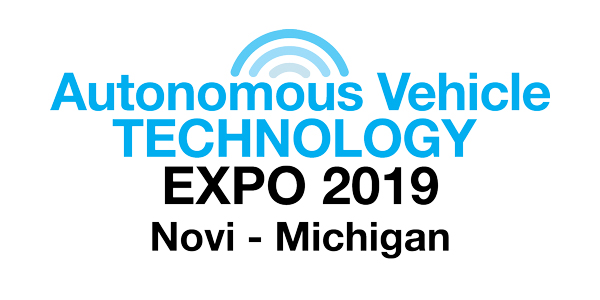The second-ever edition of Autonomous Vehicle Technology Expo in Novi, Michigan saw more than 100 exhibitors showcase their latest testing and next-generation enabling technologies specifically developed for AVs and ADAS.
Held alongside Automotive Testing Expo Novi, the event attracted thousands of visitors eager to experience live demonstrations and see new launches from a range of ADAS and AV technology leaders, including AB Dynamics, Aimotive, Aimsun, American Center for Mobility, Ann Arbor SPARK, Anyverse, AVL, b-plus, C-MORE Automotive, dSPACE, Foretellix, Keysight Technologies, MSC Software, NIRA Dynamics, Siemens and VBOX Racelogic.
“We came to see all the new technology and to see if we can implement anything from here,” said Jesse Thomas, an electrical technician visiting from General Motors. “It was cool seeing all the autonomous technology and where that’s heading. We really enjoyed the show, it was great.”
“We’re working on AVs and have a lot of demand for track testing, so we’re interested to see what’s available with the testing sites and the different systems,” said Murilo Duarte, an ADAS engineer (AV driving character) at Ford Motor Company. “In our region this is the best show for us to come to.”
New developments
Exhibitors made a number of announcements: Aimsun showcased its Aimsun Auto platform, for the design and validation of path planning algorithms for self-driving vehicles; lidar developer Xenomatix presented a compact new lidar unit, the Intercity; while Foretellix promoted its newly released M-SDL Measurable Scenario Description Language.
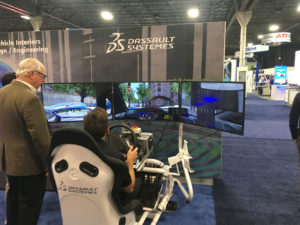 Meanwhile, PLM system developer Dassault Systèmes’ booth proved particularly busy, with a full-size driving simulator running the company’s signature product, 3DEXPERIENCE helping to draw in the crowds.
Meanwhile, PLM system developer Dassault Systèmes’ booth proved particularly busy, with a full-size driving simulator running the company’s signature product, 3DEXPERIENCE helping to draw in the crowds.
“Our software is all off the shelf,” explained solution consultant Kandarp Patel. “Our main platform is the 3DEXPERIENCE platform. Underneath, there are a number of tools – some are used to design things, some to simulate, some to manufacture or do data analytics. New releases are coming out all the time and we are constantly acquiring companies to expand our capabilities. For example, earlier this year we acquired Stimulus, which is especially useful for writing software,” continued Patel.
“What we’ve been working on a lot recently is integrating the mechanical design of a vehicle with the rest of the simulation, because that’s the final piece of your autonomous vehicle. You need to simulate the mechanical aspect together with the software. If someone is writing AI software, they need to know it will work well together with the hardware.”
Another exhibitor to catch the eye was Canadian start up, !mportant, which has adopted a unique approach to the issue of pedestrian avoidance. According to its CEO Bastien Beauchamp, the company has developed the first pedestrian-to-vehicle (P2V) standard, which allows pedestrians to transmit their position to nearby vehicles.
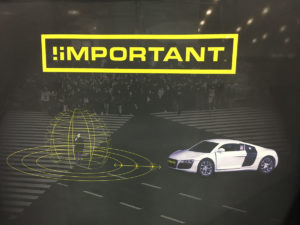 The company offers a mobile app that pedestrians can install on their phones. The issue, according to Beauchamp, is that vehicle sensors have their limitations: “At the moment, lidars cannot detect pedestrians – we’re too small. Nor can radars or sonars, because we don’t reflect the waves. That leaves only cameras, and they have their limitations, so the industry needs a P2V solution that can detect pedestrians when cameras cannot.”
The company offers a mobile app that pedestrians can install on their phones. The issue, according to Beauchamp, is that vehicle sensors have their limitations: “At the moment, lidars cannot detect pedestrians – we’re too small. Nor can radars or sonars, because we don’t reflect the waves. That leaves only cameras, and they have their limitations, so the industry needs a P2V solution that can detect pedestrians when cameras cannot.”
Beauchamp continued: “Our relationship with vehicle manufacturers is going well and growing steadily. We started two years ago and we’re having good discussions with OEMs. We’re going to announce our first implementation soon.”
The company is also in talks with mobile phone manufacturers to have this capability pre-installed on handsets, as well as on IoT devices such as smart watches, or even dedicated bracelets.
Dedicated conferences
The show also hosted also two dedicated pay-to-attend conferences: the Autonomous Vehicle Test & Development Symposium, and the ADAS & AV Legal Issues & Liabilities World Congress. The former saw some of the world’s leading engineers discuss the latest developments in autonomous vehicle research, testing, validation and development, while the latter helped clarify the legal status and risks surrounding an entirely new kind of vehicle. Speakers discussed areas such as product liability and the state of legislation, as well as privacy and cybersecurity.
More than 80 experts across both conferences shared exclusive insights from their latest research and programs, with speakers from organizations such as VW, Intel, Siemens, Uber and General Motors.
Highlights included TomTom’s Praveen Chandrasekar, who explained how HD maps create an essential fallback for the vehicle’s sensors; and professor of law Nicholas Wittner, Michigan State University, who detailed the fundamentals of product liability law in the context of ADAS and AV.
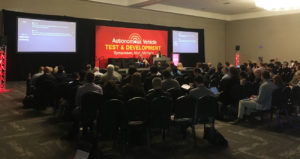 Neil Garbacik, responsible for ADAS safety and security at Fiat-Chrysler, explained how FCA is one of 11 companies taking part in the Safety First for Automated Driving (SaFAD) initiative, which sets out a framework for the development of safe automated driving systems.
Neil Garbacik, responsible for ADAS safety and security at Fiat-Chrysler, explained how FCA is one of 11 companies taking part in the Safety First for Automated Driving (SaFAD) initiative, which sets out a framework for the development of safe automated driving systems.
He went on to explain the 12 guiding principles of safe automated driving development for SAE Level 3 and Level 4 automated driving systems, derived from a comprehensive collection of publications and recommendations from public authorities and consumer associations.
The SaFAD initiative applies these principles to the development lifecycle of automated driving technology, covering requirements development through verification and validation and continuing beyond product deployment.
Garbacik urged the industry to define all the possible scenarios in which automated features can be of use, in order to create a ‘safety by design’ system, where the amount of testing that the public is involved in is reduced to a minimum: “The biggest problem that we will have to solve in the future are the problems related to the safety of the intended functionality,” he noted. “Called the ‘operational design domain’, it factors into automated driving safety as well as how human factors change the way we design our vehicles.”
Live Demo Day
New for 2019, the show experience was extended to a ‘fourth’ day (Friday, October 25), courtesy of the American Center for Mobility, which staged an exclusive Live Demo Day, where visitors were able to see some of the latest ADAS and AV testing tools put through their paces at one of North America’s leading proving grounds.
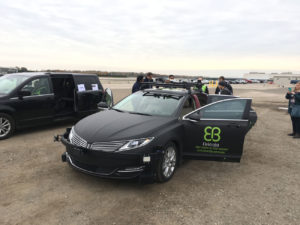 Elektrobit drove its demo car 4,200 miles, all the way from its California headquarters, in order to demonstrate the capabilities of its EB Assist Test Lab platform at the Live Demo Day. The Lincoln was outfitted with a wide range of sensors to demonstrate how EB Assist Test Lab can manage the vast amounts of data that AV and ADAS testing creates and help development teams collaborate better.
Elektrobit drove its demo car 4,200 miles, all the way from its California headquarters, in order to demonstrate the capabilities of its EB Assist Test Lab platform at the Live Demo Day. The Lincoln was outfitted with a wide range of sensors to demonstrate how EB Assist Test Lab can manage the vast amounts of data that AV and ADAS testing creates and help development teams collaborate better.
“We do not provide or own data – we provide OEMs and Tier 1s access to the platform,” explained head of technology research Jérémy Dahan. “Anyone can then partner with them through the platform. What we do is create an ecosystem where several companies can collaborate on a project. What we wanted to tackle was the problem of companies working with 10 different partners and 10 different platforms.”
EB Assist collects data from automated sensors, stores it, allows annotations to be added both manually and automatically, and then makes it available on the cloud for further processing and viewing by those working on the project.
Further companies demonstrating their latest solutions at the ACM included AB Dynamics, AVL, Keysight, Humanetics and S‑E‑A, Moshon Data, New Eagle, Racelogic and Schaeffler Group USA.
Autonomous Vehicle Technology World Expo 2020 will take place at the Suburban Collection Showplace in Novi, MI, USA, October 27, 28, 29, 2020.


